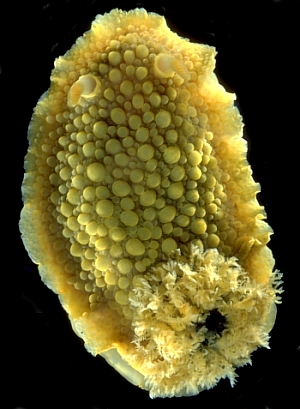
Archidoris wellingtonensis
(Abraham, 1877)
Order: NUDIBRANCHIA
Suborder: DORIDINA
Family: Dorididae
DISTRIBUTION
Found throughout New Zealand, Tasmania and Victoria, from intertidal to about 20m.
PHOTO
Devonport, Northern Tasmania, November 1985. Photo: Bill Rudman
The largest dorid (up to 200 mm) found in New Zealand waters. The body is stiff and fleshy, and covered with large, rounded to flattened pustules. Colour dark khaki brown to yellowish above, foot and rhinophores bright orange.
The egg mass is a flaccid orange spiral, 6-8 cm in diameter.
-
Abraham, P.S. (1877). Revision of the Anthobranchiate nudibranchiate mollusca, with descriptions or notices of forty-one hitherto undescribed species. Proc. Zool. Soc. London, 1877: 196-269.
-
Willan, R. & Morton, J. (1984). Marine Molluscs. Part 2 Opisthobranchia. Leigh Marine Laboratory, University of Auckland, New Zealand.
Rudman, W.B., 1998 (April 24) Archidoris wellingtonensis (Abraham, 1877). [In] Sea Slug Forum. Australian Museum, Sydney. Available from http://www.seaslugforum.net/find/archwell
Related messages
Re: Archidoris wellingtonensis from Victoria, Australia
September 30, 2009
From: Lizzie Scott
Concerning message #7729:
Dear Joan,
Having been to Inverloch of the Summer of 2008, we saw many of these nudibranch. Was wondering what they were.
Locality:Inverloch, Between 0.5 feet to 5 feet., Victoria, Australia, December 2008, Rocky reef. Length: Between 5 and 15 cm
Lizzie
lizzie-scott@hotmail.com
Scott, L., 2009 (Sep 30) Re: Archidoris wellingtonensis from Victoria, Australia. [Message in] Sea Slug Forum. Australian Museum, Sydney. Available from http://www.seaslugforum.net/find/22601Thanks Lizzie,
It's apparently quite abundant at times in Victorian waters
Best wishes,
Bill Rudman
Archidoris wellingtonensis from Dunedin, NZ
August 4, 2007
From: Megan Bosch
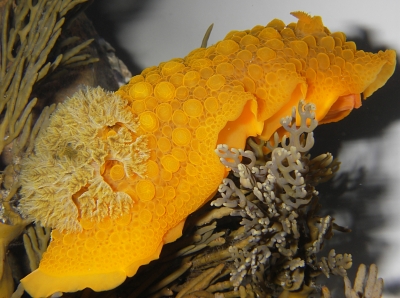
Please can you classify this species for me. It was found at Dunedin.
Locality: Dunedin, exposed rocky shore, 30 cm, New Zealand, Ocean, 2 June 2007, intertidal. Length: 25 cm. Photographer: Megan Bosch.
Megan Bosch
bosme656@student.otago.ac.nz
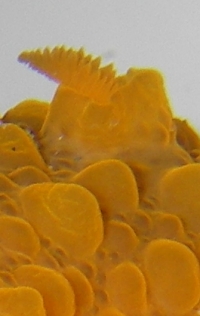
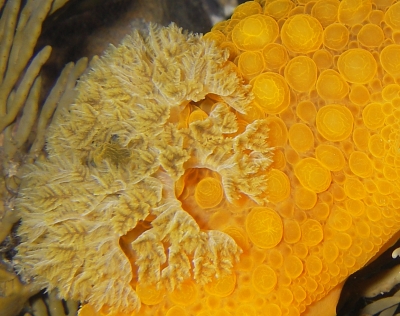
Dear Megan,
This is a not uncommon New Zealand dorid, Archidoris wellingtonensis, which as you will see on the Forum, also occurs in southeastern Australia. As you will see in my comment to a recent message [#20329] we are in a state of confusion at present over just what genus to put this species in. Recent studies suggest that the type species of Archidoris and the type species of Doris should be in the same genus, which means that Archidoris is a synonym of Doris. The problem is that no one has compared the anatomy of 'Archidoris' wellingtonensis to see whether it should have been in Archidoris in the first place. Until that is clarified there is no point in moving it to Doris. So at present I am going to continue to call this species Archidoris wellingtonensis, which is the name it has always been known by.
Best wishes,
Bill Rudman
Archidoris wellingtonensis from Tauranga, N.Z.
June 4, 2003
From: Paul Furneaux
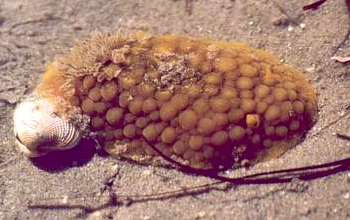
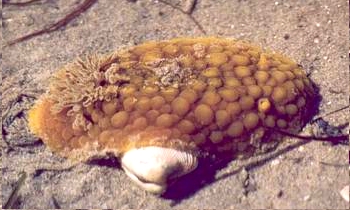
Dear Bill,
Here are some photos of what I think is Archidoris wellingtonensis. It was in the same general area of mudflats that I had found Haminoea and Philinopsis taronga, but much closer to shore - about 50m from high tide mark- the area would be covered by less than a metre of water at high tide, there are significant areas of Zostera and Ulva round about.The animal was about 7 to 8 cm long, quietly going about its business and it is the only example of this species that I have come across. [Tauranga - East Coast, New Zealand]
Thanks for your help,
Regards
Paul Furneaux.
P.Furneaux@xtra.co.nz
Furneaux, P., 2003 (Jun 4) Archidoris wellingtonensis from Tauranga, N.Z.. [Message in] Sea Slug Forum. Australian Museum, Sydney. Available from http://www.seaslugforum.net/find/10132Thanks Paul,
Archidoris wellingtonensis is usually found on a wide rang of habitats from sheltered to exposed shores, from the intertidal to about 20m. It is often found at low tide under rocks and rock ledges, but as you have discovered it is not averse to sandy mud. It feeds on encrusting yellow and orange sponges [Halichondria sp., Hymeniacidon sp. so I guess the main limiting factor is the need for surfaces on which its sponge food can grow.
Best wishes,
Bill Rudman
Archidoris wellingtonensis from Victoria, Australia
August 11, 2002
From: Joan Hales
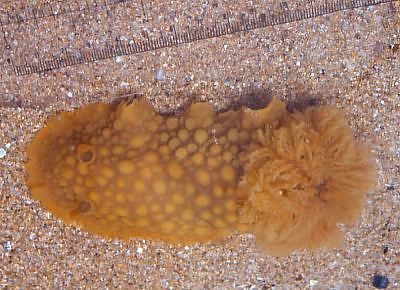
Dear Bill,
Here is a photo of Archidoris wellingtonensis from Inverloch, Victoria, Australia. The specimens seen there seem to be a brighter colour than many of those pictures on the Forum. Has not been sighted this year, but in 2000 we saw 15 on one day. [approx 13cm long]
Joan Hales
Thanks Joan,
Its nice to get photos of these relatively common species. Since these are the species most likely to be encountered, it is good to have photos showing their variability easily accessible on the Forum.
Cheers,
Bill Rudman
Re: Archidoris wellingtonensis
February 18, 1999
From: Ross Armstrong
Hi Bill
To my knowledge Archidoris wellingtonensis is the largest nudibranch in NZ. The first time I found one was at the Poor Knights I thought it was some kind of anemone.
regards
Ross
Ross@northpower.co.nz
Armstrong, R., 1999 (Feb 18) Re: Archidoris wellingtonensis. [Message in] Sea Slug Forum. Australian Museum, Sydney. Available from http://www.seaslugforum.net/find/582Archidoris wellingtonensis from New Zealand
February 17, 1999
From: Ross Armstrong
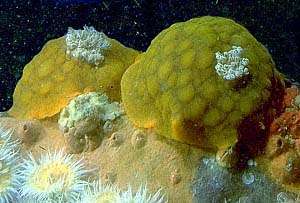
Hi Bill
Happy New Year.
Attached are some photos of Archidoris wellingtonensis I said I would send. They were taken in Whangarei Harbour [northeastern New Zealand]. We found both of them near the egg ribbon which was huge [see close-up below]. We positioned them for the photo with Diane in the background.
Regards
Ross
Ross@northpower.co.nz
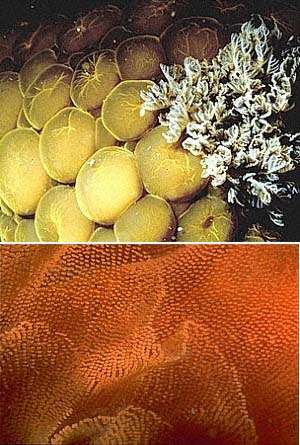
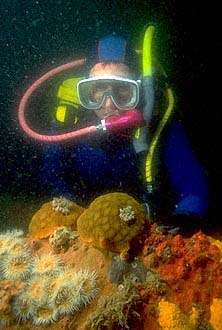
Thanks Ross,
They certainly can grow fairly large, (up to 20cm), and the egg mass can have a diameter of 8 cm. I think I am right in thinking it is New Zealand's largest nudibranch.
Bill Rudman.
Re: Archidoris from southern Tasmania
April 25, 1998
From: Karen Parsons
Bill,
Thanks so much for your quick and informative response. I will pass on the information to the person who reported it- I'm sure they will appreciate the feedback. I can't actually find the species in any of our books- maybe it doesn't appear in any illustrated publications (??)- if you happen to know of any, I'd be glad to hear.
Thanks again,
Karen Parsons
Karen.Parsons@marine.csiro.au
Parsons, K., 1998 (Apr 25) Re: Archidoris from southern Tasmania. [Message in] Sea Slug Forum. Australian Museum, Sydney. Available from http://www.seaslugforum.net/find/33No I don't think there is a published photo in any local book but there is a painting in The New Zealand Sea Shore by John Morton & Michael Miller (1968, Collins). Probably out of print but worth hunting for a secondhand copy... Bill Rudman
Archidoris from southern Tasmania
April 24, 1998
From: Karen Parsons
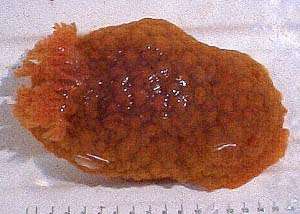
Hi Bill,
I have attached a photo of an unusual (??) nudibranch found in a dredge off southern Tasmania recently. It was found by a group who have dredged in the region for many years, but have not seen this species previously (although this may not be significant). I have sent a copy of the photo to Karen Gowlett Holmes, who works for CSIRO but is currently in SA, since she was recommended as the internal person with the most knowledge in this area. However, I thought I would send you a copy, since this is your specialty, to see if you are familiar with the beast (which is quite large; approximately 15 cm long). I realise that a photo alone may not be sufficient to make a positive ID, but any ideas would still be greatly appreciated.
Karen Parsons
CSIRO Marine Labs
Hobart, Tasmania
Karen.Parsons@marine.csiro.au
Parsons, K., 1998 (Apr 24) Archidoris from southern Tasmania. [Message in] Sea Slug Forum. Australian Museum, Sydney. Available from http://www.seaslugforum.net/find/34Your beast looks like Archidoris wellingtonensis (Abraham, 1877) which occurs throughout New Zealand and is reported from Tasmania and Victoria. It grows to over 100mm and is usually a duller khaki brown but sometimes is more orange or yellow. It is usually found from intertidal to 20m. I'm not sure how deep you specimen was found but even it was deeper than 20m I see no reason why it couldn't live as deep as its food sponges, such as Hymeniacidon, are found ..Bill Rudman.
Rudman, W.B., 1998 (Apr 24). Comment on Archidoris from southern Tasmania by Karen Parsons. [Message in] Sea Slug Forum. Australian Museum, Sydney. Available from http://www.seaslugforum.net/find/34